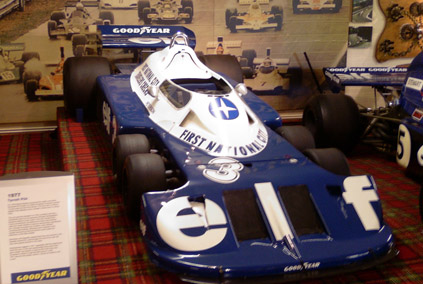 Formula car designers 1 more than once proved, that in the search for precious fractions of seconds, they have no equal. One of the unusual concepts were the six-wheeled racers.
Formula car designers 1 more than once proved, that in the search for precious fractions of seconds, they have no equal. One of the unusual concepts were the six-wheeled racers.
The real flood of such solutions took place in the second half of the years 70. Back then, most racing teams were using the same drivetrain – Ford Cosworth DFV engine and Hewland gearbox. The advantage over the rivals should therefore be sought in other areas – aerodynamics remained at a fairly low level, and for turbochargers and the use of the so-called. Venturi tubes had to wait a few more years to generate more clamping force. However, nothing stood in the way, to work on the mechanical traction of cars. Under these conditions, the Tyrrell P34 was created, which appeared on the Formula One tracks 1 in 1976 r.
Designer Derek Gardner was primarily concerned with the greatest possible gain in traction while reducing air resistance. Therefore, instead of the front axle, he used a system of two axles with smaller wheels than before. Diameter wheels 10 inches were completely hidden behind a thick, aerodynamically shaped front wing. Thanks to this, it was possible to slightly reduce the air resistance, though not completely – in years 70. Formula One rear wheels 1 they were much larger than they are today (in 1976 year, the maximum width of the rear tire was 21 cali, i.e. approx 53 Cm). The air still met resistance in the form of two huge tires at the rear. The rest of the car was conventional and resembled the previous Tyrrell model marked with the symbol 007.
By increasing adhesion (In the Tyrrell P34, the front end of the car touched the road at four points instead of two) understeer was significantly reduced, which positively influenced the behavior of the vehicle in slow and medium-speed corners. Better tire contact with the road also allowed for more effective braking.
The first starts of the six-wheeled Tyrrell showed, that it has a lot of potential. Jody Scheckter and Patrick Depailler regularly finished in the lead, and in the Swedish Grand Prix they took the first two places. Nevertheless, the race at Anderstorp was the last such major success. Ultimately, Scheckter and Depailler finished third and fourth in the standings, with a significant loss to the top two. The experiment continued the following season. However, the problem quickly arose. Tire supplier Goodyear focused on competing with Michelin, letting go of working on the tires completely, which only Tyrrell used. The small front Goodyearys warmed up much slower than the rear ones, and correspondingly soft tread compounds were lacking, hence the six wheelers became very difficult to steer. Attempts were made to increase the track of the front wheels in search of the lost grip, but to no avail. Another disadvantage was the unfavorable weight distribution – additional elements of the suspension and braking and steering systems made, that the center of gravity has been shifted excessively forward.
In 1977 For the first time in the team's seven-year history, Tyrrell did not win a race for the first time. The unusual design did not work out. Another Tyrrell – model 008
it was already a fully conventional racer. Ideas of other teams introduced in the same period, like turbocharged engines (Renault, 1977 r.) or the use of a Venturi tube in the undercarriage structure (Lotus, 1977 r.), turned out to be much more successful.